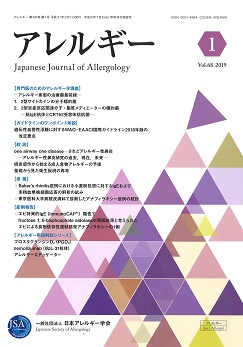
- |<
- <
- 1
- >
- >|
-
Kenji Izuhara2019 Volume 68 Issue 1 Pages 1-7
Published: 2019
Released on J-STAGE: February 20, 2019
JOURNAL FREE ACCESSDownload PDF (804K) -
Koichiro Asano2019 Volume 68 Issue 1 Pages 8-14
Published: 2019
Released on J-STAGE: February 20, 2019
JOURNAL FREE ACCESSDownload PDF (363K)
-
Michihiro Hide2019 Volume 68 Issue 1 Pages 16-19
Published: 2019
Released on J-STAGE: February 20, 2019
JOURNAL FREE ACCESSDownload PDF (368K)
-
Yoshitaka Okamoto2019 Volume 68 Issue 1 Pages 20-23
Published: 2019
Released on J-STAGE: February 20, 2019
JOURNAL FREE ACCESSDownload PDF (746K) -
Yuko Chinuki2019 Volume 68 Issue 1 Pages 24-28
Published: 2019
Released on J-STAGE: February 20, 2019
JOURNAL FREE ACCESSDownload PDF (380K) -
Akio Matsuda2019 Volume 68 Issue 1 Pages 29-34
Published: 2019
Released on J-STAGE: February 20, 2019
JOURNAL FREE ACCESSDownload PDF (416K)
-
Takenori Haruna, Mitsuhiro Okano, Tazuko Fujiwara, Takaya Higaki, Shin ...2019 Volume 68 Issue 1 Pages 35-42
Published: 2019
Released on J-STAGE: February 20, 2019
JOURNAL FREE ACCESSBackground: Baker's rhinitis is a kind of occupational allergic rhinitis mainly caused by intranasal exposure to wheat and/or rye flour in bakery workers. Continuous exposure to flour may induce the onset of asthma in these patients.
Method: We experienced a case of 34-year-old male with baker's rhinitis without asthma, and investigated responses of IgE and peripheral blood mononuclear cells (PBMCs) to flour extracts used in the bakery in practice.
Result: In the immunoblotting, the patient's IgE reacted with 18 and 30kDa molecules in the extracts of 6 flours used in the bakery. The patient's PBMC produced a substantial amount of IL-5 and IL-13 in response to these flour extracts.
Conclusion: It is suggested that water/salt soluble components of wheat flour selectively induce type 2 cytokines production in baker's rhinitis.
View full abstractDownload PDF (1037K) -
Risa Jo, Tomonobu Ito, Tomoko Kobayashi, Taro Miura, Shiro Mishima, Hi ...2019 Volume 68 Issue 1 Pages 43-47
Published: 2019
Released on J-STAGE: February 20, 2019
JOURNAL FREE ACCESSObjective: There are few epidemiological reports of anaphylaxis since childhood. We herein examined cases of anaphylaxis diagnosed in our department.
Methods: One hundred-thirty-two patients who were examined at the Dermatology Department of Tokyo Medical University Hospital between January 2011 and March 2017 and were prescribed epinephrine autoinjector (EpiPen®) for treatment were enrolled. The referral institution if any, severity of anaphylaxis, diagnostic method, causative antigen, and recurrence rate was examined.
Results: The referral rate was 54% while 46% of patients requested examination of their own accord. Anaphylaxis severity was mild to moderate in 75% of cases. Food allergy accounted for 71% of the symptoms, with wheat as the most common causative antigen, followed by Anisakis allergy. After diagnosis only 37% of patients continued periodic consultations, and 16 patients recurred anaphylaxis of the diagnosis.
Conclusion: Wheat and WDEIA were the most frequent causes of anaphylaxis diagnosed in our department. We also found that as many as 15% of patients had Anisakis allergy, suggesting that it may be an important item in antigen testing.
View full abstractDownload PDF (356K)
-
Kyoko Tonomura, Rai Fujimoto, Yosuke Okuda, Norihito Iba, Sachiko Saka ...2019 Volume 68 Issue 1 Pages 48-53
Published: 2019
Released on J-STAGE: February 20, 2019
JOURNAL FREE ACCESSA 16-year-old male high-school student experienced generalized itchy wheal and dyspnea during physical exercise after lunch. Each food material of his lunch was examined using a prick-prick test, allergen-specific IgE test (ImmunoCAP®), and provocation test. The prick-prick test was positive for black tiger shrimp (raw and heated) and white leg shrimp (heated). Allergen-specific IgE test (ImmunoCAP®) showed absolutely negativity for all suspected foods. The food-exercise provocation test using heated black tiger shrimp with additional aspirin intake finally induced anaphylaxis.
We studied the IgE-binding molecules from shrimp using a purification procedure and Western blotting, with sera from the patient and several controls. A 40-kDa protein, corresponding to FBA, was found to be the major IgE-binding allergen component in this patient. Currently, the precise history and the prick-prick test using both raw and heated shrimps are useful to diagnose shrimp-induced FDEIA. Because the allergen-specific IgE test is insufficient to diagnose the cause of the symptoms, a component allergen-specific IgE test after the identification of the causative allergenic protein, such as FBA, is required.
View full abstractDownload PDF (378K)
-
[in Japanese]2019 Volume 68 Issue 1 Pages 54-55
Published: 2019
Released on J-STAGE: February 20, 2019
JOURNAL FREE ACCESSDownload PDF (234K) -
[in Japanese], [in Japanese]2019 Volume 68 Issue 1 Pages 56-57
Published: 2019
Released on J-STAGE: February 20, 2019
JOURNAL FREE ACCESSDownload PDF (193K) -
[in Japanese]2019 Volume 68 Issue 1 Pages 58
Published: 2019
Released on J-STAGE: February 20, 2019
JOURNAL FREE ACCESSDownload PDF (185K)
-
2019 Volume 68 Issue 1 Pages 71-72
Published: 2019
Released on J-STAGE: February 20, 2019
JOURNAL FREE ACCESSDownload PDF (286K)
- |<
- <
- 1
- >
- >|